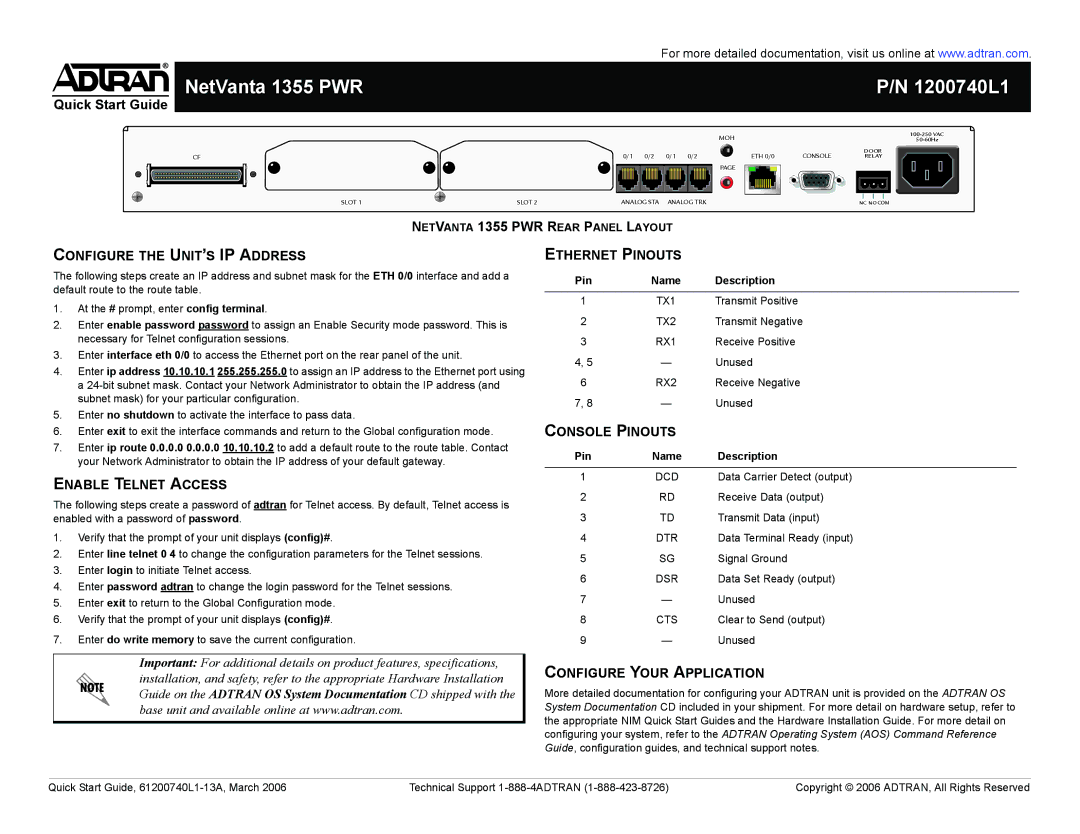
®
Quick Start Guide
For more detailed documentation, visit us online at www.adtran.com.
NetVanta 1355 PWR | P/N 1200740L1 |
MOH | |
| 0/1 | 0/2 | 0/1 | 0/2 | ETH 0/0 | CONSOLE | DOOR |
CF | RELAY | ||||||
|
|
|
|
| PAGE |
|
|
SLOT 1 |
| SLOT 2 | ANALOG STA ANALOG TRK | NC NO COM |
NETVANTA 1355 PWR REAR PANEL LAYOUT
CONFIGURE THE UNIT’S IP ADDRESS
The following steps create an IP address and subnet mask for the ETH 0/0 interface and add a default route to the route table.
1.At the # prompt, enter config terminal.
2.Enter enable password password to assign an Enable Security mode password. This is necessary for Telnet configuration sessions.
3.Enter interface eth 0/0 to access the Ethernet port on the rear panel of the unit.
4.Enter ip address 10.10.10.1 255.255.255.0 to assign an IP address to the Ethernet port using a
5.Enter no shutdown to activate the interface to pass data.
6.Enter exit to exit the interface commands and return to the Global configuration mode.
7.Enter ip route 0.0.0.0 0.0.0.0 10.10.10.2 to add a default route to the route table. Contact your Network Administrator to obtain the IP address of your default gateway.
ENABLE TELNET ACCESS
The following steps create a password of adtran for Telnet access. By default, Telnet access is enabled with a password of password.
1.Verify that the prompt of your unit displays (config)#.
2.Enter line telnet 0 4 to change the configuration parameters for the Telnet sessions.
3.Enter login to initiate Telnet access.
4.Enter password adtran to change the login password for the Telnet sessions.
5.Enter exit to return to the Global Configuration mode.
6.Verify that the prompt of your unit displays (config)#.
7.Enter do write memory to save the current configuration.
ETHERNET PINOUTS
Pin | Name | Description |
|
|
|
1 | TX1 | Transmit Positive |
2 | TX2 | Transmit Negative |
3 | RX1 | Receive Positive |
4, 5 | — | Unused |
6 | RX2 | Receive Negative |
7, 8 | — | Unused |
CONSOLE PINOUTS
Pin | Name | Description |
|
|
|
1 | DCD | Data Carrier Detect (output) |
2 | RD | Receive Data (output) |
3 | TD | Transmit Data (input) |
4 | DTR | Data Terminal Ready (input) |
5 | SG | Signal Ground |
6 | DSR | Data Set Ready (output) |
7 | — | Unused |
8 | CTS | Clear to Send (output) |
9 | — | Unused |
Important: For additional details on product features, specifications, installation, and safety, refer to the appropriate Hardware Installation Guide on the ADTRAN OS System Documentation CD shipped with the base unit and available online at www.adtran.com.
CONFIGURE YOUR APPLICATION
More detailed documentation for configuring your ADTRAN unit is provided on the ADTRAN OS System Documentation CD included in your shipment. For more detail on hardware setup, refer to the appropriate NIM Quick Start Guides and the Hardware Installation Guide. For more detail on configuring your system, refer to the ADTRAN Operating System (AOS) Command Reference Guide, configuration guides, and technical support notes.
Quick Start Guide, | Technical Support | Copyright © 2006 ADTRAN, All Rights Reserved |
